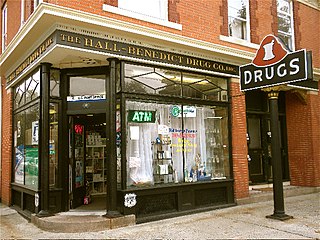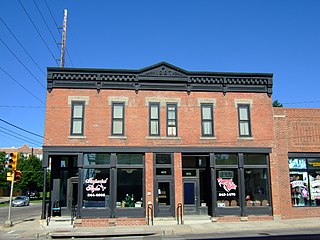
The Sugar Hill Historic District is a historic district in Detroit, Michigan. It contains 14 structures located along three streets: East Forest, Garfield, and East Canfield, between Woodward Avenue on the west and John R. on the east. The district was listed on the National Register of Historic Places in 2003.

The Cass Park Historic District is a historic district in Midtown Detroit, Michigan, consisting of 25 buildings along the streets of Temple, Ledyard, and 2nd, surrounding Cass Park. It was listed on the National Register of Historic Places in 2005 and designated a city of Detroit historic district in 2016.

The Jefferson–Chalmers Historic Business District is a historic district located on East Jefferson Avenue between Eastlawn Street and Alter Road in Detroit, Michigan. The district is the only continuously intact commercial district remaining along East Jefferson Avenue, and was listed on the National Register of Historic Places in 2004.

The Abrams Building was located at South Pearl Street and Hudson Avenue in Albany, New York, United States. It was a brick commercial building constructed in the 1880s. In 1980 it was listed on the National Register of Historic Places.

The Chesterton Commercial Historic District is a historic district in Chesterton, Indiana.

The Hall-Benedict Drug Company Building is a historic commercial building at 763-767 Orange Street in the East Rock neighborhood of New Haven, Connecticut. Built in 1909 to house a pharmacy, it is a little-altered and well-preserved example of an early 20th-century mixed residential-commercial neighborhood building. The building was listed on the National Register in 1986. It is also a contributing property in the Whitney Avenue Historic District.

The Wupperman Block/I.O.O.F. Hall is a historic building located just north of downtown Davenport, Iowa, United States. It was listed on the National Register of Historic Places in 1983.

The Henry Berg Building is a historic building located in downtown Davenport, Iowa, United States. It has been listed on the National Register of Historic Places since 1983. It is on the same block as Davenport Bank and Trust, Central Office Building and 202 W. Third Street. It is also next to the Ficke Block on Harrison Street. All of these structures are listed on the National Register.

Peters’ Barber Shop is a historic building located in the West End of Davenport, Iowa, United States. It was completed in 1905 and it has been listed on the National Register of Historic Places since 1984.

The Baker-Devotie-Hollingsworth Block is an historic building located in the East Village of Des Moines, Iowa, United States. The eastern two-thirds of the block was listed on the National Register of Historic Places in 1978 as the Studio Building. The western one-third was added to the National Register in 2008, and its name was changed at that time.

The Wherry Block, also known as Wherry's Hall, Scruby Brothers Grocery, and Scruby's Grocery Store, is an historic building located in Des Moines, Iowa, United States.

The Drake University Campus Historic District is located in Des Moines, Iowa, United States. The historic district contains six buildings. Five of the buildings are collegiate buildings on the Drake University campus and one is a church. The period of significance is from when the university was founded in 1881 to the end of the presidency of Hill M. Bell in 1918. The historic district has been listed on the National Register of Historic Places since 1988. It is part of the Drake University and Related Properties in Des Moines, Iowa, 1881—1918 MPS.

The Sherman Hill Historic District is located in Des Moines, Iowa, United States. It is one of the oldest residential suburbs in Des Moines. Single-family houses were constructed beginning around 1880 and multi-family dwellings were built between 1900 and 1920. The district encompasses 80 acres (0.32 km2) and 210 buildings and is bounded by 15th Street, Woodland Avenue, Martin Luther King Parkway and School Street. The historic district has been listed on the National Register of Historic Places since 1979.

The Sixth and Forest Historic District is located in Des Moines, Iowa, United States. It is a Victorian era suburban commercial district on the northeastern and northwestern corners of the junction of 6th and Forest Avenues, and originally contained six buildings. The buildings on the northeast corner have subsequently been torn down. The historic district has been listed on the National Register of Historic Places since 1996. It is a part of the Towards a Greater Des Moines MPS.

Hedge Block, also known as Johnson-Rasmussen Building, is a historic commercial building located in the central business district of Burlington, Iowa, United States. It was individually listed on the National Register of Historic Places in 1982. It was included as a contributing property in the West Jefferson Street Historic District in 1991 and in the Downtown Commercial Historic District in 2015.

The New Center Commercial Historic District is a commercial historic district located on Woodward Avenue between Baltimore Street and Grand Boulevard in Detroit, Michigan. It was listed on the National Register of Historic Places in 2016.

The Seth Richards Commercial Block, also known as the Lederer-Strauss Building, is an historic building located in downtown Des Moines, Iowa, United States. Its construction represents the transition of Court Avenue from a retail center to the city's wholesale district. Seth Richards had the acquired the property that hd been the location of several business houses. One of the lots had been owned by the Independent Order of Odd Fellows. The four-story, brick, Romanesque Revival building was constructed in two parts. The commercial blocks at 300-302 and 304-306 were completed and occupied in 1890, and 308-310 was completed and occupied by 1897. Various wholesale clothing firms occupied the various blocks, but by 1920 Lederer, Strauss & Co., Inc., a millinery fabricator and wholesaler, occupied the entire building. The family run business was sold in 1944 to the Hiersteiners, who incorporated the business as the Landsco Millinery Co. The business was scaled back, and they occupied less of the block, which was filled with other wholesalers by the mid-1950s. In 1957 the Landsco Millinery Co. was liquidated. The building has been converted for other retail uses in the Court Avenue Entertainment District after this area ceased being a wholesale center. It was listed on the National Register of Historic Places in 2005.

The Masonic Temple, also known as the A.F. & A.M. Hall, Masonic Building, Greeley Building, and the Octagon Center for the Arts, is a historic building located in Ames, Iowa, United States. Built between 1916 and 1917, the three-story, brick, Neoclassical building was designed by the Des Moines architectural firm of Liebbe, Nourse & Rasmussen. It was commissioned by Wallace M. Greeley, an Ames banker and civic leader. The buildiing was built at the high point of Progressive era construction in the central business district, and with a several other noteworthy public and semi-public buildings, marked Ames' transition from a rural town to a modern city. Arcadia Lodge #249 occupied the third floor of the building from its completion in 1917 to 1997, when they built a new building on Alexander Avenue.

The I.O.O.F. Valley Junction Lodge Hall No. 604 is a historic building located in West Des Moines, Iowa, United States. C.S. Yeaton had the two-story brick commercial building constructed from 1897 to 1898. Des Moines architect C.C. Cross was responsible for the design of the Italianate structure. The International Order of Odd Fellows took possession of the building in 1907. A single-story addition was added behind 218 Fifth Street sometime before 1920, and the current storefronts were in place before 1968. The commercial space on the main floor housed a grocer, various hardware stores, and a dry cleaners over the years. The fraternal organization occupied the second floor. The tripartite main facade features two mirror halves. The floor levels in the two storefronts are raised, which is an unusual feature in the surrounding commercial district. The building was individually listed on the National Register of Historic Places in November 2017. The month before it had been included as a contributing property in the Valley Junction Commercial Historic District.



























